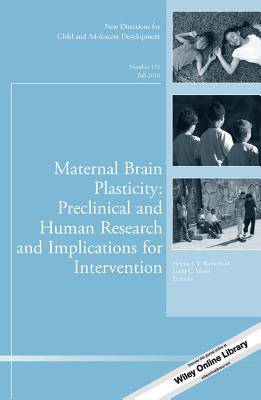
- Afhalen na 1 uur in een winkel met voorraad
- Gratis thuislevering in België vanaf € 30
- Ruim aanbod met 7 miljoen producten
- Afhalen na 1 uur in een winkel met voorraad
- Gratis thuislevering in België vanaf € 30
- Ruim aanbod met 7 miljoen producten
Zoeken
€ 30,95
+ 61 punten
Omschrijving
The transition to motherhood is marked by significant change at both biological and psychological levels, facilitating the development of maternal behavior. Interdisciplinary research converge to highlight the plasticity of the maternal brain, and the interplay of neurophysiology and postpartum experience, in shaping maternal brain and behavior.
In this issue, new directions on the topic of the plasticity of the maternal brain is discussed by internationally renowned experts. Taking a lifespan developmental and crossspecies perspective, it highlights biological and environmental influences, including neuroendocrine events around parturition and offspring interactions, in shaping maternal brain plasticity. This issue highlights the importance of maternal periods of neural plasticity as optimal temporal windows for targeted interventions in families to foster maternal behavior and child development. This provides a unique opportunity to synergistically bring together research scientists with clinical teams that routinely work with mothers and their children to support and prosper the dyadic relationship through innovative translational research programs.
In this issue, new directions on the topic of the plasticity of the maternal brain is discussed by internationally renowned experts. Taking a lifespan developmental and crossspecies perspective, it highlights biological and environmental influences, including neuroendocrine events around parturition and offspring interactions, in shaping maternal brain plasticity. This issue highlights the importance of maternal periods of neural plasticity as optimal temporal windows for targeted interventions in families to foster maternal behavior and child development. This provides a unique opportunity to synergistically bring together research scientists with clinical teams that routinely work with mothers and their children to support and prosper the dyadic relationship through innovative translational research programs.
This is the 153rd volume in this Jossey-Bass series New Directions for Child and Adolescent Development. Its mission is to provide scientific and scholarly presentations on cutting edge issues and concepts in this subject area. Each volume focuses on a specific new direction or research topic and is edited by experts from that field.
Specificaties
Betrokkenen
- Auteur(s):
- Uitgeverij:
Inhoud
- Aantal bladzijden:
- 144
- Taal:
- Engels
- Reeks:
Eigenschappen
- Productcode (EAN):
- 9781119318484
- Verschijningsdatum:
- 9/09/2016
- Uitvoering:
- Paperback
- Formaat:
- Trade paperback (VS)
- Afmetingen:
- 147 mm x 226 mm
- Gewicht:
- 204 g

Alleen bij Standaard Boekhandel
+ 61 punten op je klantenkaart van Standaard Boekhandel
Beoordelingen
We publiceren alleen reviews die voldoen aan de voorwaarden voor reviews. Bekijk onze voorwaarden voor reviews.











